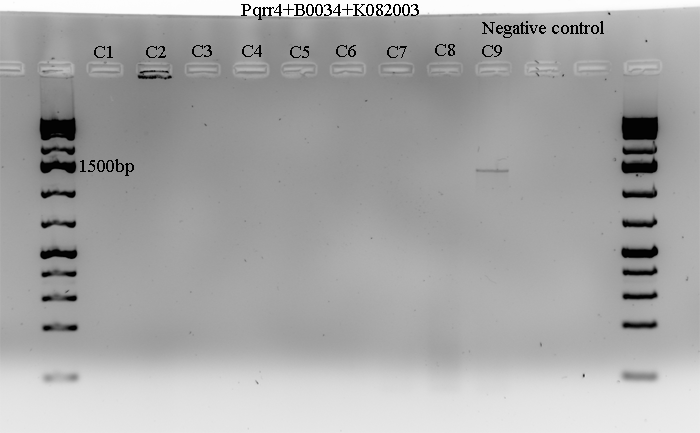Now that hopefully the whole reporter circuit is transformed into TOP10 cells, I have performed a colony PCR of those colonies with Biobrick CP F/R primers and with the following conditions:
94°C for 3 min; 36x (94°C for 30s; 53°C for 45s; 72°C for 1 min and 20s;) 72°C for 10 min; held at 4°C.
Using Biobrick CP primers was a mistake, however, because I should have used
Pqrr4 F primer and Biobrick CP reverse primer. This would have allowed me to verify whether or not
Pqrr4 was not cut out during the construction. Another mistake was noticed, as I did not load any positive size control. Without any positive size controls to compare against, it is hard for me to tell whether or not it contains every piece of the circuit. Because of today's mistakes, I am planning to run another cPCR of the reporter circuit with 2 positive size controls,
Pqrr4 by itself and
Pqrr4 with B0034, and use
Pqrr4 Forward and biobrick CP Reverse primers.
The cPCR products were ran on 2% agarose gel, at 90 volts, and the following image is the picture of the gel.
Figure 1. cPCR of
Pqrr4+B0034(RBS)+K082003(GFP+LVA)

Colonies 1 to 8 did not get amplified at all, and Colony 9 seemed to have been amplified, but not of the right size. The expected size is about 1043bp with some additional length added due to the primers annealing outside, and the band in Colony 9 lane is a bit higher than the expected size.
Modelling meeting
Anders, one of our facilitators, came and gave us an advise on modelling. We discussed about limitations, advantages of our characterization methods and what we should focus on.
Updated Wiki notebooks from May 26 to June 11
Because our wiki notebook page has been created recently by Mandy, we were not able to post our previous updates, so old updates are now being done along with the recent updates.

